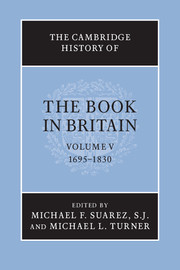Book contents
- Frontmatter
- Introduction
- PART I THE QUANTITY AND NATURE OF PRINTED MATTER
- PART II ECONOMIC, LEGAL AND CULTURAL CONTEXTS
- PART III THE TECHNOLOGIES AND AESTHETICS OF BOOK PRODUCTION
- PART IV THE BOOK TRADE AND ITS MARKETS
- V BOOKS AND THEIR READERS
- I RELIGIOUS BOOKS
- II LITERATURE AND THE CULTURE OF LETTERS
- 33 Book reviewing
- 34 Publishing contemporary English literature, 1695–1774
- 35 British literature, 1774–1830
- 36 Scholarly editing: patristics, classical literature and Shakespeare
- 37 The reprint trade
- III SPECIALIST BOOKS AND MARKETS
- Abbreviations used in bibliography
- Bibliography
- Index
- Frontispiece
- Plate section
- References
34 - Publishing contemporary English literature, 1695–1774
from II - LITERATURE AND THE CULTURE OF LETTERS
Published online by Cambridge University Press: 28 September 2010
- Frontmatter
- Introduction
- PART I THE QUANTITY AND NATURE OF PRINTED MATTER
- PART II ECONOMIC, LEGAL AND CULTURAL CONTEXTS
- PART III THE TECHNOLOGIES AND AESTHETICS OF BOOK PRODUCTION
- PART IV THE BOOK TRADE AND ITS MARKETS
- V BOOKS AND THEIR READERS
- I RELIGIOUS BOOKS
- II LITERATURE AND THE CULTURE OF LETTERS
- 33 Book reviewing
- 34 Publishing contemporary English literature, 1695–1774
- 35 British literature, 1774–1830
- 36 Scholarly editing: patristics, classical literature and Shakespeare
- 37 The reprint trade
- III SPECIALIST BOOKS AND MARKETS
- Abbreviations used in bibliography
- Bibliography
- Index
- Frontispiece
- Plate section
- References
Summary
Drama
Dramatic texts were steady sellers. Evidently, Samuel Johnson was not alone in believing that ‘A play read, affects the mind like a play acted.’ There was a demand for copies of less popular works as well as standard parts of the repertory because readers commonly collected the works of important dramatic authors. Until c. 1715, dramatic texts almost invariably were first published as quartos, following a tradition dating back to the Renaissance. By the 1720s, however, most first editions were octavos, a change accounted for in part by the significantly increased size of the sheet. Octavo continued to be te preferred format while a play was still enjoying publishing success, but many subsequently came on to the market as more economical duodecimos. According to B.J. McMullin, it was the Hague bookseller Thomas Johnson who established the small octavo and duodecimo formats for the reprinting of canonical English plays. One advantage of printing plays in smaller formats was that they could be carried in the pockets of theatre audiences. Typically plays cost between 1s. and 2s., depending on format, popularity and pressure from pirated editions; 1s. 6d. and 1s. were most common.
New productions of old plays, if they did reasonably well, often occasioned new editions. In the comic repertoire, for example, Congreve, Vanbrugh, Cibber, Farquhar and Steele were repeatedly staged and frequently reprinted. Sales of the dead – and successful living – authors subsidized the publication of new works: plays as well as poems and, later, prose fiction. Until John Bell’s Shakespeare’s plays (9 vols., 1773–4) and his British theatre (21 vols., 1776–81), printed plays seldom reflected alterations for performance made by the acting companies. Because the 1737 Licensing Act (10 George II, c. 38) imposed censorship only on the performance of plays, and did not govern the contents of printed texts, expurgated passages could be included without legal constraint. Naturally, publishers of plays that had been modified for the stage by the Licenser often made the printing of censored passages a primary selling point.
- Type
- Chapter
- Information
- The Cambridge History of the Book in Britain , pp. 649 - 666Publisher: Cambridge University PressPrint publication year: 2009

